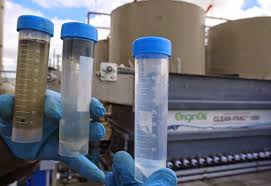There are well over
3,000 companies around the world that are involved in some element of
wastewater treatment, providing a broad mix of technology, equipment or
engineering services to generators and collectors of fouled water. A small group in this wide field is gaining
visibility - the ‘water gleaners.’ Like the peasant women picking up stray grains
of wheat left behind in the empty field of Millets famous painting, some see
value in effluents, sewage and run-off.
In this post we look at three small-companies with novel technologies to
harvest water.



New Sky Energy is a
private company based in Boulder, Colorado, has developed several waste
recycling processes, including carbon dioxide capture, sour natural gas
sweetening. The company’s ‘SaltCycle’
process converts industrial and agricultural brines into useful chemicals that
have economic value. It is an appealing
alternative to having to pay for disposal.
The SaltCycle
process involves two steps. In the first
step brines are concentrated and purified to produce useful salts such as sodium
chloride or sodium sulfate. Then in step
two, the salts are put into a chemical or electrochemical reactor to produce acid,
base and sulfate. Soda ash or
bicarbonate can be produced from the base.
Sales of the end products can be used to pay for upstream water
treatment or as a power source for the SaltCycle reactor.
New Sky has focused on the water waste streams
of the oil and gas industry. However,
the company has also been calling on mining companies, landfill operations,
agriculture, and other manufacturers. One
element that helps the New Sky pitch is the scalability of its systems and the
availability of engineering services to help optimize operations. Patents
protect the technology behind its three primary waste converting systems.
With all that
going for New Sky Energy, there is little for investors. Management holds its cards fairly close to
the corporate vest, making only a few customer announcements and saying little
about partners or investors. Still New
Sky Energy is an interesting company to watch for future developments in this
expanding market for sustainable industrial processes.
MagneGas Corporaton (MNGA:
Nasdaq) has been a topic of past
articles. The November 14, 2015 post “Industrial Plasma of MagneGas” outlined
how the company is using its plasma arc technology to gasify carbon-rich
liquids such as municipal wastewater to produce hydrogen gas. The company markets the gas for industrial
applications such as metal cutting. It
widely seen as a replacement for acetylene and has been adopted by fire
departments emergency situations requiring safer metal cutting tools. MagneGas2 is being used by two subcontractors
in the expansion of the Vehicle Assembly Building at NASA’s Kennedy Space
Center. Most recently the company received an order
from a major gas company in Mexico for industrial metal cutting.
As a public
company MagneGas provides investors a pure play on wastewater reclamation and
reuse. Unfortunately, ‘industrial
sustainability’ is also a ‘small play.’
In the twelve months ending December 2015, the company reported $2.3
million in total sales, resulting in a net loss of $8.8 million. MagneGas is also still using cash resources
to support operations - $5.6 million in that same twelve-month
period. With only $2.2 million in cash
remaining in the bank at the end of December 2015, a ramp in sales cannot come
fast enough for MagneGas.
OriginClear (OOIL:
OTC) was the focus of the post “More than a Water Boy for Algae Industry”
published on October 23, 2015. The
company has developed an ‘electro water separation’ process that uses
electricity to collect oil and suspended solids in waste water. The solids are removed with ‘advanced
oxidation’ to return clean, decontaminated water back to the industrial
system. OriginClear markets its system
has application in settings where oil contaminates water such as in hydraulic fracturing
of oil and gas wells. However, it also
has application in the production of algae for fish feed. Both industries are large water users and
benefit from being able to recycle and reuse water rather than having to pay
for both water replenishment and wastewater disposal.
Through the acquisition
of Progressive Water Treatment based in Dallas, Texas, OriginClear took its
first step in the reclamation of foul water.
Progressive brought with it a portfolio of water treatment systems for
municipal and industrial waters using reverse osmosis technologies. More recently the company launched a joint
venture with a Malaysian engineering firm, Osmocell Malaysia, which has
successfully deployed twenty filtration and reverse osmosis systems for water
purification. The joint venture claims
over $1.0 million in proposals and bids in its business pipeline. Malaysia is the world center for rubber glove
manufacturing, which uses water-intensive processes that leave organics and
ammonia in process water.
OriginClear has
yet to record significant revenue and still requires cash resources to support
operations. Consequently, its stock is
priced in the pennies as an option on management’s ability to conserve cash
resources long enough to get the revenue pump primed and generating higher
numbers at the top-line. Cash totaled
$695,295 at the end of December 2015. With
a cash usage rate near $250,000 per month, there is some concern about how long
OriginClear can last without a dramatic increase in revenue. That said, the company did have $1.0 million
in contracts receivable on the balance sheet, so collections could save the day. Furthermore, the Progressive Water Treatment
operation acquired in October 2015, is expect to add $6.5 million to the
top-line in 2016.
Management of
OriginClear is also actively in the hunt for additional acquisition and joint
venture partners. While we expect that large
group of over 3,000 companies to consolidate, it is tough to see OriginClear,
with it barebones balance sheet, as a consolidator.
Neither the author of the Small Cap Strategist web
log, Crystal Equity Research nor its affiliates have a beneficial interest in
the companies mentioned herein.
No comments:
Post a Comment